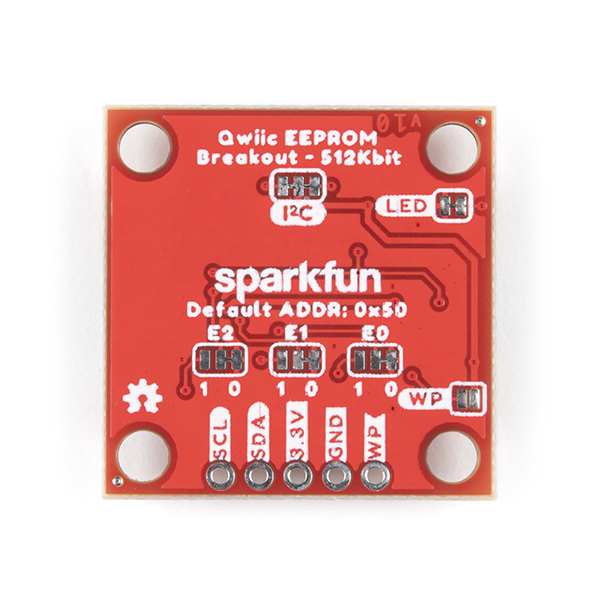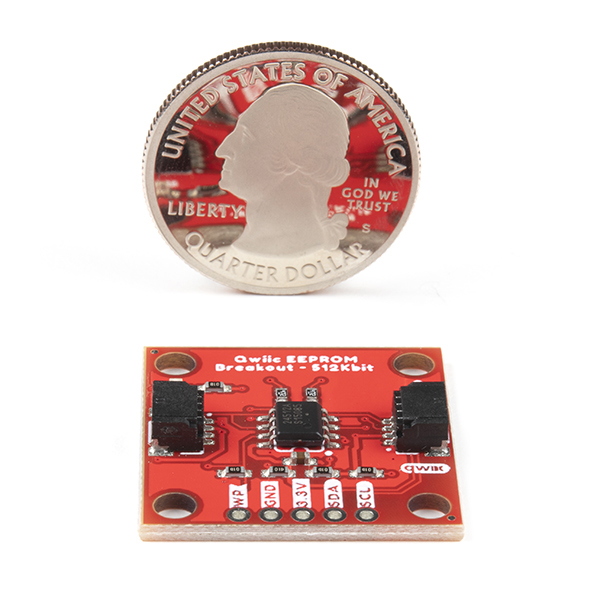SparkFun Qwiic EEPROM Breakout - 512Kbit
The SparkFun Qwiic EEPROM Breakout is a simple and cost effective option to add some extra storage space to any project. With 512 kilo-bits (or 64 kilo-bytes) of storage, this product is great for any microcontroller that doesn't have any EEPROM storage space, like the SAMD21. You can use the Qwiic EEPROM for storing data like GPS waypoints and other user settings that need to be maintained between sketch uploads. The SparkFun Qwiic EEPROM has three address jumpers, allowing for up to eight EEPROMs on one bus. All communication is enacted exclusively via I2C, utilizing our handy Qwiic system (as the name implies). However, we still have broken out 0.1" spaced pins in case you prefer to use a breadboard.
The on-board CAT24C512 IC is a 512Kb EEPROM flash memory, organized as 65,536 words of 8 bits each with a 128-byte page write buffer. An on board ECC (Error Correction Code) makes this EEPROM suitable for high reliability applications. The IC also offers write protection, which inhibits write operations by pulling the WP pin High (protects the entire memory). The external address pins make it possible to connect up to eight CAT24C512 EEPROM chips on the same I2C bus.
We've also made sure to write an Arduino library to make using this and any EEPROM easy to use. Check it out by searching 'SparkFun EEPROM' from the Arduino library manager or by downloading the repo directly.
Note: The I2C address of the EEPROM - 512Kbit is 0x50 and is jumper selectable to 0x51, 0x52, 0x53, 0x54, 0x55, 0x56, or 0x57. A multiplexer/Mux is required to communicate to multiple EEPROM - 512Kbit sensors on a single bus. If you need to use more than one EEPROM Breakout consider using the Qwiic Mux Breakout.
The SparkFun Qwiic Connect System is an ecosystem of I2C sensors, actuators, shields and cables that make prototyping faster and less prone to error. All Qwiic-enabled boards use a common 1mm pitch, 4-pin JST connector. This reduces the amount of required PCB space, and polarized connections mean you can’t hook it up wrong.
- Power: 3.3V
- CAT24C512 EEPROM:
- Supply Current:
- Read Current: 1mA
- Write Current: 1.8mA - 2.5mA
- Memory: 512-Kb (kilobit)
- Page Write Buffer: 128 bytes
- Reliability:
- Endurance: 1,000,000 Program/Erase Cycles
- Data Retention: 100 Years
- Write Protection
- I2C Address (7-bit):
- 0x50 (Default), 0x51, 0x52, 0x53, 0x54, 0x55, 0x56, 0x57
- Supply Current:
- 2x Qwiic Connectors
SparkFun Qwiic EEPROM Breakout - 512Kbit Product Help and Resources
Reading and Writing Serial EEPROMs
August 11, 2017
EEPROM is a great way to add extra memory to your microcontroller project. Wait 'til you see how easy it is to use!
Qwiic EEPROM Hookup Guide
July 29, 2021
Running out of memory? Don't forget to check out the Qwiic EEPROM!
Core Skill: Programming
If a board needs code or communicates somehow, you're going to need to know how to program or interface with it. The programming skill is all about communication and code.
Skill Level: Rookie - You will need a better fundamental understand of what code is, and how it works. You will be using beginner-level software and development tools like Arduino. You will be dealing directly with code, but numerous examples and libraries are available. Sensors or shields will communicate with serial or TTL.
See all skill levels
Core Skill: Electrical Prototyping
If it requires power, you need to know how much, what all the pins do, and how to hook it up. You may need to reference datasheets, schematics, and know the ins and outs of electronics.
Skill Level: Rookie - You may be required to know a bit more about the component, such as orientation, or how to hook it up, in addition to power requirements. You will need to understand polarized components.
See all skill levels
Comments
Looking for answers to technical questions?
We welcome your comments and suggestions below. However, if you are looking for solutions to technical questions please see our Technical Assistance page.
Customer Reviews
No reviews yet.




